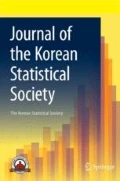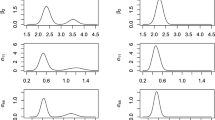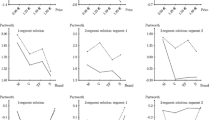Abstract
The independence of irrelevant alternatives (IIA) property states that the ratio of any two choice probabilities in a set of alternatives is independent of the presence or absence of other alternatives. In the modeling of multinomial data, the IIA is not feasible. In this situation, the multinomial probit (MNP) model is a type of discrete choice model that is commonly used. Due to the identifiability problem and the positive-definiteness constraint, modeling the covariance matrix in the MNP is difficult. All existing methods use unidentifiable parameters in the covariance matrix to solve the unidentifiability problem and improve the rate of convergence of a data augmentation algorithm. These methods also use the inverse Wishart distribution, which is frequently insufficient (Barnard et al. Stat Sin 10(4):1281–1311, 2000). We employed variance-correlation decomposition to decompose the identifiable covariance matrix into standard deviations and a correlation matrix instead of using the unidentifiable covariance matrix. Hypersphere decomposition was also used to decompose the correlation matrix. Thus, the estimated covariance matrix satisfied the positive definiteness constraint. The performance of our proposed model was illustrated using a detergent dataset from market research.
Similar content being viewed by others
References
Aichison, J., & Bennett, J. (1970). Polychotomous quantal response by maximum indicant. Biometrika, 57, 253–262.
Albert, J., & Chib, S. (1993). Bayesian analysis of binary and polychotomous response data. Journal of the American Statistical Association, 88(422), 669–679.
Barnard, J., McCulloch, R., & Meng, X.-L. (2000). Modeling covariance matrices in terms of standard deviations and correlations, with application to shrinkage. Statistica Sinica, 10(4), 1281–1311.
Burgette, L. F., & Nordheim, E. V. (2012). The trace restriction: An alternative identification strategy for the Bayesian multinomial probit model. Journal of Business & Economic Statistics, 30, 404–410.
Chib, S., Greenberg, E., & Chen, Y. (1998). MCMC methods for fitting and comparing multinomial response models. Econometrics. University Library of Munich.
Chintagunta, P., & Prasad, A. (1998). An empirical investigation of the “dynamic mcfadden’’ model of purchase timing and brand choice: Implications for market structure. Journal of Business & Economic Statistics, 16(1), 2–12.
Daniels, M. J., & Zhao, Y. D. (2003). Modelling the random effects covariance matrix in longitudinal data. Statistics in Medicine, 22(10), 1631–1647.
Gelman, A. (2006). Prior distributions for variance parameters in hierarchical models (comment on article by browne and draper). Bayesian Analysis, 1(3), 515–534.
Gelman, A., Carlin, J. B., Stern, H. S., Dunson, D. B., Vehtari, A., & Rubin, D. B. (2013). Bayesian data analysis (3rd ed.). Chapman & Hall/CRC.
Gelman, A., & Rubin, D. B. (1999). Inference from iterative simulations using multiple sequences (with discussion). Statistical Science, 27, 457–472.
Imai, K., & van Dyk, D. (2005). A Bayesian analysis of the multinomial probit model using marginal data augmentation. Journal of Econometrics, 124, 311–334.
Imai, K., & Van Dyk, D. A. (2005). MNP: R package for fitting the multinomial probit model. Journal of Statistical Software, 14(3), 1–32.
Lee, K., Cho, H., Kwak, M.-S., & Jang, E. J. (2020). Estimation of covariance matrix of multivariate longitudinal data using modified choleksky and hypersphere decompositions. Biometrics, 76(1), 75–86.
Lerman, S., & Manski, C. (1981). On the use of simulated frequencies to approximate choice probabilities. Structural Analysis of Discrete Data with Econometric Applications, 10, 305–319.
Loaiza-Maya, R., & Nibbering, D. (2021). Scalable Bayesian estimation in the multinomial probit model. Journal of Business & Economic Statistics, 40(4), 1678–1690.
Loaiza-Maya, R., & Nibbering, D. (2022). Fast variational inference for multinomial probit model. Working Paper, 1–30.
McCulloch, R., & Rossi, P. (1994). An exact likelihood analysis of the multinomial probit model. Journal of Econometrics, 64, 207–240.
McFadden, D. (1989). A method of simulated moments for estimation of discrete response models without numerical integration. Econometrica, 57, 995–1026.
Nobile, A. (1998). A hybrid markov chain for the Bayesian analysis of the multinomial probit model. Statistics and Computing, 8, 229–242.
Pinheiro, J. C., & Bates, D. M. (1996). Unconstrained parametrizations for variance–covariance matrices. Statistics and Computing, 6, 289–296.
Spiegelhalter, D., Best, N., Carlin, B., & Van Der Linde, A. (2002). Bayesian measures of model complexity and fit. Journal of the Royal Statistical Society: Series B (Statistical Methodology), 64, 583–639.
Tsay, R. S., & Pourahmadi, M. (2017). Modelling structured correlation matrices. Biometrika, 104, 237–242.
Watanabe, S. (2010). Asymptotic equivalence of bayes cross validation and widely applicable information criterion in singular learning theory. Journal of Machine Learning Research, 11, 3571–3594.
Zhang, X., Boscardin, W. J., & Belin, T. R. (2008). Bayesian analysis of multivariate nominal measures using multivariate multinomial probit models. Computational Statistics & Data Analysis, 15, 3697–3708.
Zhang, W., Leng, C., & Tang, C. Y. (2015). A joint modelling approach for longitudinal studies. Journal of the Royal Statistical Society: Series B (Statistical Methodology), 77(1), 219–238.
Acknowledgements
This project was supported by Basic Science Research Program through the National Research Foundation of Korea (KRF) funded by the Korean government (NRF-2022R1A2C1002752) for Keunbaik Lee.
Author information
Authors and Affiliations
Corresponding author
Additional information
Publisher's Note
Springer Nature remains neutral with regard to jurisdictional claims in published maps and institutional affiliations.
Rights and permissions
Springer Nature or its licensor (e.g. a society or other partner) holds exclusive rights to this article under a publishing agreement with the author(s) or other rightsholder(s); author self-archiving of the accepted manuscript version of this article is solely governed by the terms of such publishing agreement and applicable law.
About this article
Cite this article
Koo, D., Kim, C. & Lee, K. A Bayesian method for multinomial probit model. J. Korean Stat. Soc. 52, 265–281 (2023). https://doi.org/10.1007/s42952-022-00200-5
Received:
Accepted:
Published:
Issue Date:
DOI: https://doi.org/10.1007/s42952-022-00200-5




